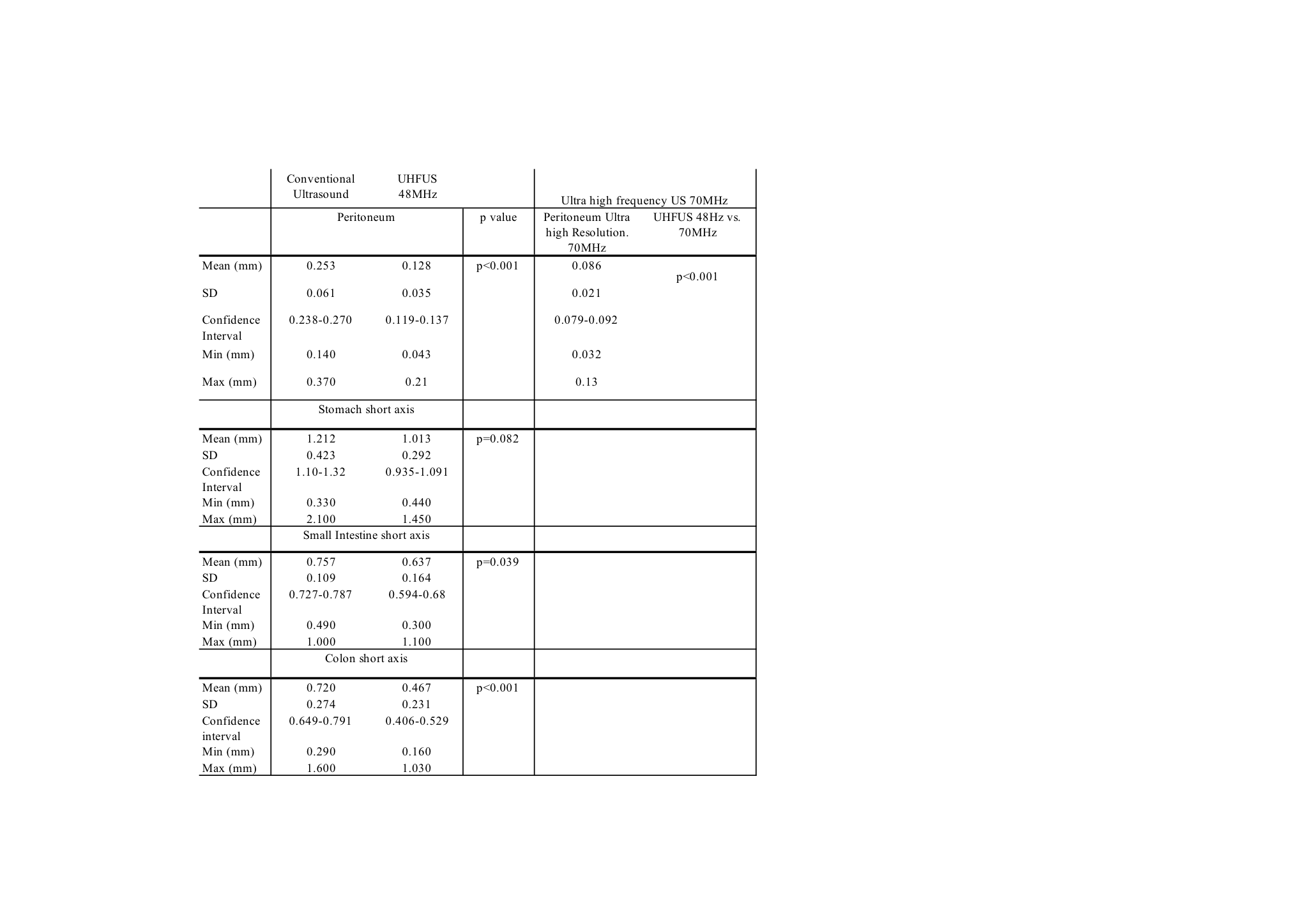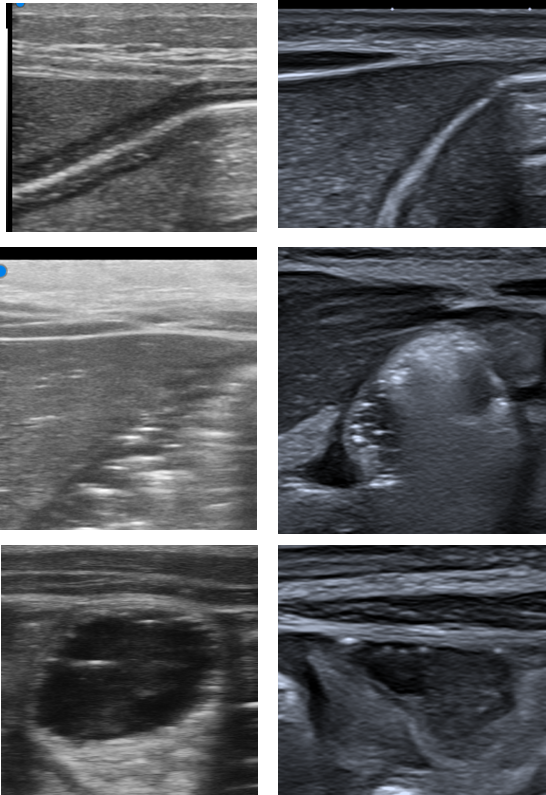Neonatal GI Physiology & NEC
Category: Abstract Submission
Neonatal GI Physiology & NEC III
515 - Ultra-high frequency ultrasound (48-70MHz) is a promising tool for improved gastrointestinal diagnostics in infants
Monday, April 25, 2022
3:30 PM - 6:00 PM US MT
Poster Number: 515
Publication Number: 515.426
Publication Number: 515.426
Ronni B. Jacobsen, Aalborg University Hospital, Aalborg, Nordjylland, Denmark; Hanna Hebelka, Institute of clinical sciences, Västra Frölunda, Vastra Gotaland, Sweden; Vladimir Gatzinsky, Queen Silvia Childrens Hospital, Gothenburg, Vastra Gotaland, Sweden; Anders Elfvin, University of Gothenburg, Molndal, Vastra Gotaland, Sweden; Frida Dangardt, Pediatric Heart Center, The Queen Silvia Children’s Hospital, Gothenburg, Vastra Gotaland, Sweden
- RJ
Ronni B. Jacobsen, MD
Consultant
Aalborg University Hospital
Aalborg, Nordjylland, Denmark
Presenting Author(s)
Background: Earlier detection of gastrointestinal pathology in preterm and term newborn infants could potentially improve the morbidity and mortality in conditions of acute gastrointestinal conditions, for example necrotizing enterocolitis (NEC). Advances in the field of ultrasonography have enabled more refined imaging using ultra high frequency ultrasound (UHFUS, 48-70MHz) giving higher resolution. Bringing this novel method into a clinically feasible setting for preterm and term infants has not yet been investigated.
Objective: To investigate the clinical feasibility of UHFUS to examine the peritoneum and the gastrointestinal wall thickness of newborn infants, in the search of an improved diagnostic method.
Design/Methods: In this prospective study, 19 healthy term newborn infants at a mean gestational age of 39.8 weeks (37.7-41.3) on day 1 to 6, were examined at the same occasion with abdominal ultrasound both with conventional ultrasound (CUS) (Toshiba, Aplio i700, linear probe 14L5) and UHFUS (Visualsonics VevoMD, linear probes UHF48 and UHF70) according to a standardized setting. Gastrointestinal measurements (off-line) of wall thickness were performed for; stomach, small intestine, colon and for peritoneal thickness. If Crypts of Lieberkuhn were seen this was registered. The measurements for CUS and UHFUS were performed simultaneously to ensure that the measures were obtained in corresponding segments.
Results: We found significant differences in mean thickness between measurements with CUS and UHFUS (48 MHz); for peritoneum 0.253 vs. 0.128 mm (p < 0.001), the small intestine (short axis) 0.757 mm vs. 0.637 mm (p=0.039) and colon (short axis) 0.72 mm vs. 0.467 mm (p < 0.001). Gaining frequency on UHFUS from 48 to 70 MHz showed a reduction in measurements of mean thickness of peritoneum from 0.128 mm to 0.086 mm (p < 0.001). Crypts of Lieberkuhn in the small intestine could only be seen with UHFUS, in 14 of the 19 (73.7 %) infants.Conclusion(s): UHFUS was demonstrated as a clinical feasible, promising method to examine the gastrointestinal wall and the peritoneum in infants. Significantly lower values of measurements of the peritoneum and gastrointestinal wall thickness was demonstrated with UHFUS compared to CUS. Interestingly also measurements obtained with CUS were lower as compared with existing literature why updated measures obtained with both UHFUS and CUS are suggested in order to challenge the existing conceptual "normal" values for these structures. Thus, UHFUS is a promising tool for improved gastrointestinal diagnostics in infants.
Peritoneal, stomach, small intestine and colon wall mean thickness in mm measured with conventional and ultra high frequency ultrasound 48 and 70MHz.
Example of pictures obtained with UHFUS 48MHz (left) and CUS (right) for the stomach (top), the colon (middle) and the small intestine (bottom)
Objective: To investigate the clinical feasibility of UHFUS to examine the peritoneum and the gastrointestinal wall thickness of newborn infants, in the search of an improved diagnostic method.
Design/Methods: In this prospective study, 19 healthy term newborn infants at a mean gestational age of 39.8 weeks (37.7-41.3) on day 1 to 6, were examined at the same occasion with abdominal ultrasound both with conventional ultrasound (CUS) (Toshiba, Aplio i700, linear probe 14L5) and UHFUS (Visualsonics VevoMD, linear probes UHF48 and UHF70) according to a standardized setting. Gastrointestinal measurements (off-line) of wall thickness were performed for; stomach, small intestine, colon and for peritoneal thickness. If Crypts of Lieberkuhn were seen this was registered. The measurements for CUS and UHFUS were performed simultaneously to ensure that the measures were obtained in corresponding segments.
Results: We found significant differences in mean thickness between measurements with CUS and UHFUS (48 MHz); for peritoneum 0.253 vs. 0.128 mm (p < 0.001), the small intestine (short axis) 0.757 mm vs. 0.637 mm (p=0.039) and colon (short axis) 0.72 mm vs. 0.467 mm (p < 0.001). Gaining frequency on UHFUS from 48 to 70 MHz showed a reduction in measurements of mean thickness of peritoneum from 0.128 mm to 0.086 mm (p < 0.001). Crypts of Lieberkuhn in the small intestine could only be seen with UHFUS, in 14 of the 19 (73.7 %) infants.Conclusion(s): UHFUS was demonstrated as a clinical feasible, promising method to examine the gastrointestinal wall and the peritoneum in infants. Significantly lower values of measurements of the peritoneum and gastrointestinal wall thickness was demonstrated with UHFUS compared to CUS. Interestingly also measurements obtained with CUS were lower as compared with existing literature why updated measures obtained with both UHFUS and CUS are suggested in order to challenge the existing conceptual "normal" values for these structures. Thus, UHFUS is a promising tool for improved gastrointestinal diagnostics in infants.
Peritoneal, stomach, small intestine and colon wall mean thickness in mm measured with conventional and ultra high frequency ultrasound 48 and 70MHz.

Example of pictures obtained with UHFUS 48MHz (left) and CUS (right) for the stomach (top), the colon (middle) and the small intestine (bottom)

